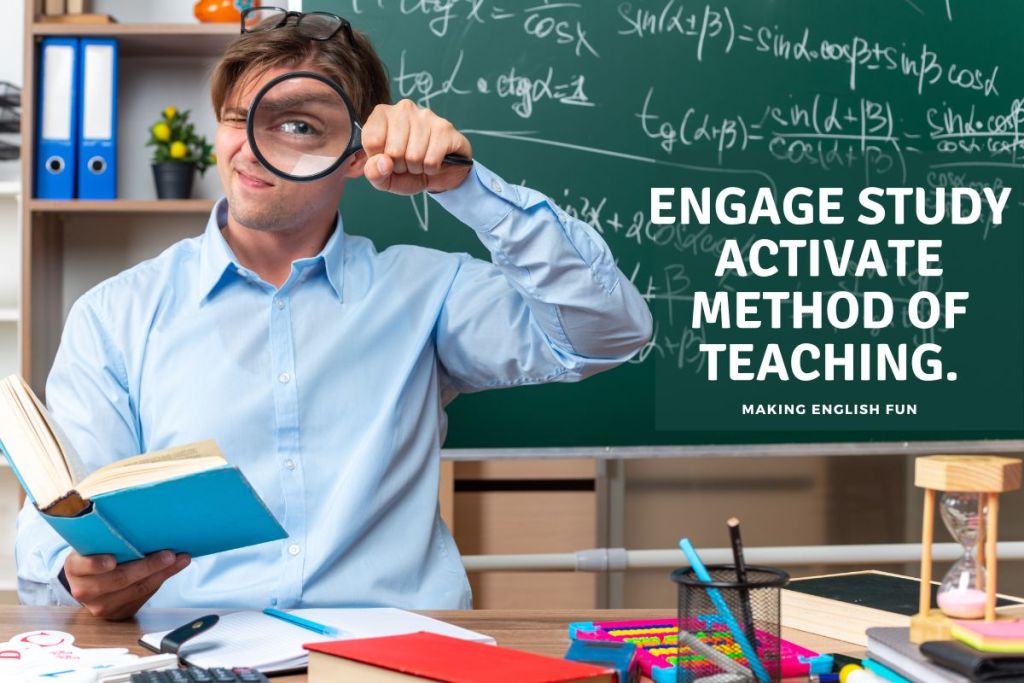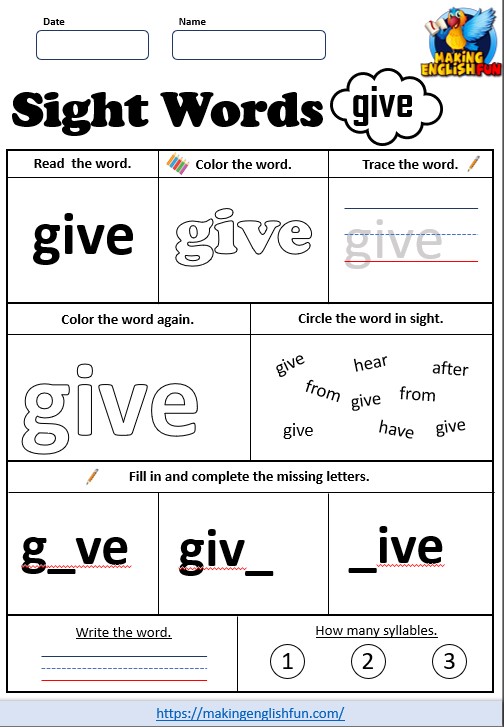Engage Study Activate Method of Teaching.
Welcome to a practical exploration of the ESA (Engage, Study, Activate) teaching method, a straightforward and effective approach to language instruction. Developed by Jeremy Harmer, this method has gained popularity among ESL/EFL teachers for its simplicity and effectiveness.
ESA Method in teaching involves three key stages: ‘Engage’ to captivate interest and enthusiasm of students, ‘Study’ for focused learning, practice and retention, and ‘Activate’ to apply language learnt practically and usefully, enhancing students’ comprehension and fluency in real-life contexts.
ESA stands on these three pillars: Engage, Study, and Activate, each playing a crucial role in the learning process.
As teachers, we’re always looking for ways to make our lessons more engaging and effective, and ESA offers just that.
It encourages students to be active participants in their learning journey, starting with engaging activities, moving through focused study, and culminating in practical language use.
This introduction is designed to give you, fellow educators, an insight into how ESA works and how it can transform your teaching approach to better meet the needs of your language learners.
Let’s take a look and discover how ESA can make a difference in your classroom.

2: The Three Phases of ESA – A Detailed Look
As language teachers, our goal is to make lessons as effective and engaging as possible. The ESA (Engage, Study, Activate) method, developed by Jeremy Harmer, offers a clear and adaptable framework to achieve this.
Let’s break down each of the three phases to understand how they contribute to successful language learning.
Engage Phase
The Engage phase is all about getting students interested and ready to learn. This is where we, as educators, set the tone for the lesson.
- Purpose: The main goal here is to awaken the students’ interest, get them thinking in English, and mentally prepare them for the lesson. It’s about creating an atmosphere where students are ready and eager to learn.
- Activities: To engage students, you can use a variety of techniques such as interesting questions, short stories, discussions about familiar topics, games, or songs. The key is to choose activities that are not only fun but also relatable to the students. For instance, discussing a current event, sharing a humorous anecdote, or playing a quick word game can effectively engage students.
- Teacher’s Role: In this phase, our role is to be facilitators. We need to encourage participation from all students and create a comfortable environment where they feel confident to express their ideas.
Study Phase
After capturing the students’ interest, we move to the Study phase, where the focus is on the language or information that students need to learn.
- Purpose: This phase is about language acquisition and practice. Here, students are introduced to new vocabulary, grammar points, pronunciation, or language skills (like reading or writing).
- Activities: Study activities can include drills, gap-fill exercises, sentence building, pronunciation practice, or grammar exercises. It’s important to ensure these activities are challenging yet achievable for your students. For example, if you’re teaching new vocabulary, you could use matching exercises, followed by sentence construction using the new words.
- Teacher’s Role: Our role becomes more directive in this phase. We introduce new language concepts, provide clear explanations, and correct mistakes. It’s crucial to give clear instructions and ensure students understand the language being taught.
Activate Phase
The final phase of the ESA method is Activate, where students use the language they have learned in a meaningful and creative way.
- Purpose: The aim here is to encourage fluency and to allow students to practice language in a context as close to real life as possible. It’s about getting students to communicate using the language they’ve learned.
- Activities: Activate activities are designed to get students to use language as freely and creatively as possible. These can include role-plays, debates, storytelling, problem-solving activities, or discussions. For example, if the lesson is about past tense verbs, you could have students share a personal story from their past.
- Teacher’s Role: In this phase, we step back and allow students to do most of the talking. Our job is to facilitate, offer support, and provide feedback. It’s essential to create a safe space where students can try out the language without fear of making mistakes.
Each phase of the ESA method plays a vital role in the language learning process.
- Engage gets students interested and thinking in English,
- Study focuses on new language and concepts, and
- Activate allows students to use the language in a practical, communicative way.
By understanding and effectively implementing each of these phases, we can create dynamic, effective, and enjoyable language learning experiences for our students.

3: Implementing ESA in the Classroom
Successfully integrating the ESA (Engage, Study, Activate) method into your language teaching requires thoughtful planning and adaptation to your students’ needs.
Here’s a brief guide on how to implement ESA effectively in the classroom.
Lesson Planning with ESA
- Balancing the Phases: A well-structured ESA lesson should balance all three phases, though not necessarily in equal parts. The length and intensity of each phase can vary depending on the lesson’s objectives and the students’ level.
- Flexibility: While ESA follows a sequence, it’s not rigid. Feel free to revisit the Engage phase midway through a lesson if you feel the class’s energy dipping, or return to Study after Activate if you notice gaps in understanding.
Tailoring ESA to Student Levels
- Adjusting for Levels: Adapt the complexity of activities in each phase according to your students’ proficiency levels. For beginners, the Study phase might need more time and simpler activities, while advanced students might benefit from longer and more challenging Activate phases.
- Inclusivity in Activities: Ensure that activities cater to different learning styles. Include visual, auditory, and kinesthetic elements to engage all students.
Feedback and Assessment in ESA
- Constructive Feedback: Provide timely and constructive feedback, especially during the Study and Activate phases. This helps students understand their mistakes and learn from them.
- Assessment Strategies: Use a variety of assessment methods to gauge students’ progress. This can include formal tests, quizzes, or informal assessments like observing participation and language use during the Activate phase.
Implementing ESA effectively requires understanding its flexibility and adaptability to different teaching contexts.
By carefully planning and tailoring your lessons, and providing thoughtful feedback and assessment, you can maximize the benefits of the ESA method, creating a dynamic and engaging learning environment for your students.
4: Variations of the ESA Method
While the Engage, Study, Activate (ESA) sequence is effective, it’s not a one-size-fits-all solution. Understanding its variations can help tailor your teaching approach to different classroom dynamics and student needs.
Boomerang, Straight Arrow and Patchwork ESA
- Straight Arrow ESA: This is the most common practical use of the ESA method, and like the name suggests it follows the Engage – Study – Activate line straight, like well, an arrow. You can read more about this on the link.
- Boomerang ESA: This variation involves starting with an Engage activity, followed by an initial Activate phase before moving to the Study phase. The lesson then circles back to another Activate phase. It’s particularly useful for lessons focused on communication skills, as it allows students to experiment with the language first before delving into the specifics. There is a link to how to implement Boomerang ESA here
- Patchwork ESA: As the name suggests, this format is more flexible and involves various sequences of Engage, Study, and Activate phases. It’s like a patchwork quilt of activities that can be adapted based on how the class is progressing. This format allows for a lot of creativity and can be very engaging for students.
We have a more focused article on the differences between the three methods of E.S.A here on the site and you can check that out on the link later.
Customizing ESA to Fit Your Style
- Teacher’s Discretion: The beauty of ESA lies in its adaptability. Feel free to modify the structure based on what works best for your teaching style and your students’ learning preferences.
- Responsive Teaching: Be prepared to modify your lesson plan on the go. If a particular phase is really resonating with the class, it’s okay to extend it. Conversely, if something isn’t working, it’s fine to move on.
Understanding and utilizing these variations of the ESA method can add a dynamic and responsive element to your teaching, ensuring that your lessons are as effective and engaging as possible.

5: Challenges and Solutions in ESA
Implementing the ESA method in language teaching can present certain challenges. Here’s how to identify and address some common issues:
Overcoming Common Challenges
- Engagement Difficulties: Sometimes, students may not respond to engagement activities. To counter this, vary your activities and try to connect them to the students’ interests or current events.
- Complex Study Phases: If students struggle during the Study phase, consider breaking down the information into smaller, more digestible parts. Use different teaching aids to cater to various learning styles.
- Lack of Participation in Activate Phase: Encourage quieter students by creating a supportive atmosphere where mistakes are seen as part of the learning process. Group activities can also help less confident students to participate more.
Finding Solutions
- Flexibility in Lesson Planning: Be prepared to adapt your lesson plan. If an activity isn’t working, don’t hesitate to switch gears.
- Student-Centered Approach: Focus on the students’ needs and responses. Tailor your approach to suit their level and interests, and encourage their input in choosing activities.
By being adaptable and student-focused, you can overcome common challenges in using the ESA method, leading to more effective and enjoyable language learning experiences.
6: ESA in Different Teaching Contexts
The ESA method is versatile and can be adapted to various teaching contexts, from traditional classrooms to online environments.
Online vs. In-Person Teaching
- Online Adaptation: In online settings, leverage digital tools for the Engage phase, like interactive polls or videos. During the Study phase, screen sharing and online whiteboards can be effective. For Activate, encourage participation through breakout rooms and online discussions.
- Maintaining Interaction: Whether teaching online or in-person, the key to a successful ESA lesson is interaction. Ensure that students are actively participating and not just passively receiving information.
Cultural Considerations in ESA
- Cultural Sensitivity: Be mindful of cultural differences in communication styles and learning. What works in one cultural context may not be effective in another.
- Inclusivity: Ensure that the materials and activities are inclusive and respectful of all students’ backgrounds. This is especially important in diverse classrooms where students come from various cultural backgrounds.
Adapting the ESA method to fit different teaching environments and being culturally sensitive can enhance the effectiveness of your language teaching, making it more inclusive and responsive to diverse student needs.
7: Case Study – Implementing ESA with a Dinosaur-Themed Lesson
| Phase | Description | Example for a Dinosaur-Themed Lesson |
|---|---|---|
| Engage | This phase aims to capture students’ interest and get them excited about the topic, setting the stage for learning. | Activity: Show real dinosaur fossils to the class to spark curiosity. Discuss what dinosaurs might have looked like and sounded like, encouraging students to share their thoughts and ideas about dinosaurs. |
| Study | Focuses on learning and understanding new language concepts, such as vocabulary, grammar, or pronunciation. | Activity: Use Virtual Reality (VR) to explore a prehistoric landscape and learn about different dinosaurs. Complement this with interactive books that show dinosaur names, encouraging students to practice pronouncing and spelling these names. |
| Activate | Encourages students to use the language in a creative and practical way, emphasizing fluency. | Activity: Conduct a reading and spelling challenge where students read dinosaur names from flashcards and spell them out loud. Turn it into a game, awarding points for correct pronunciation and spelling to make it fun and engaging. |
Overview of the Lesson
The lesson focused on phonics and spelling, using dinosaurs as the central theme. Aimed at a group of young learners, the lesson’s objective was to engage students with the exciting world of dinosaurs while teaching them phonetic skills and spelling.
Engage Phase
- Activity: The teacher started by showing real dinosaur fossils, sparking curiosity among the students. This tactile experience immediately captured the students’ attention and set the stage for an immersive learning experience.
- Impact: Handling the fossils helped create a lively atmosphere, making the students eager to learn more about dinosaurs and related vocabulary.
Study Phase
- Activity: The lesson then shifted to a Virtual Reality (VR) exploration of a prehistoric landscape. Students virtually interacted with different dinosaurs, learning their names and practicing phonetic sounds. The VR experience was supplemented with interactive books that illustrated dinosaur names and related phonetic sounds.
- Impact: The VR and interactive books effectively demonstrated the pronunciation and spelling of complex dinosaur names, making it easier for students to grasp and remember.
Activate Phase
- Activity: For the Activate phase, the teacher organized a reading and spelling challenge. Students were asked to read aloud dinosaur names from flashcards and spell them. This activity was turned into a fun game, with points awarded for correct pronunciation and spelling.
- Impact: This phase allowed students to actively use the vocabulary and phonics rules they learned. The game element made the activity engaging and encouraged participation from all students.
Teacher and Student Feedback
- Teacher’s Perspective: The teacher observed increased enthusiasm and participation from the students. They noted that the use of real fossils and VR technology greatly enhanced the engagement and effectiveness of the lesson.
- Student’s Perspective: Students reported that the lesson was one of their most enjoyable. The hands-on and interactive elements made learning about dinosaurs and practicing phonics fun and memorable.
Conclusion
Our exploration of the ESA (Engage, Study, Activate) teaching method demonstrates its versatility and effectiveness in language education.
From the engaging use of real dinosaur fossils and VR technology in a phonics lesson to the practical tips for implementing ESA in various teaching contexts, it’s clear that this method offers a dynamic approach to language learning.
The ESA method, with its focus on engaging students, carefully structuring the study phase, and providing opportunities for active language use, is more than just a teaching strategy; it’s a pathway to creating more interactive, student-centered learning experiences.
The adaptability of ESA to different educational settings, from traditional classrooms to online learning environments, underscores its relevance in today’s diverse educational landscape.
We also have a breakdown of other advice, tips and tricks if you need to check up after this. you can access them from the links below.
- What is the ESA Teaching Method
- The Straight Arrow Method
- The Boomerang ESA Method
- The Patchwork ESA Method
- Differences between E.S.A Methods







